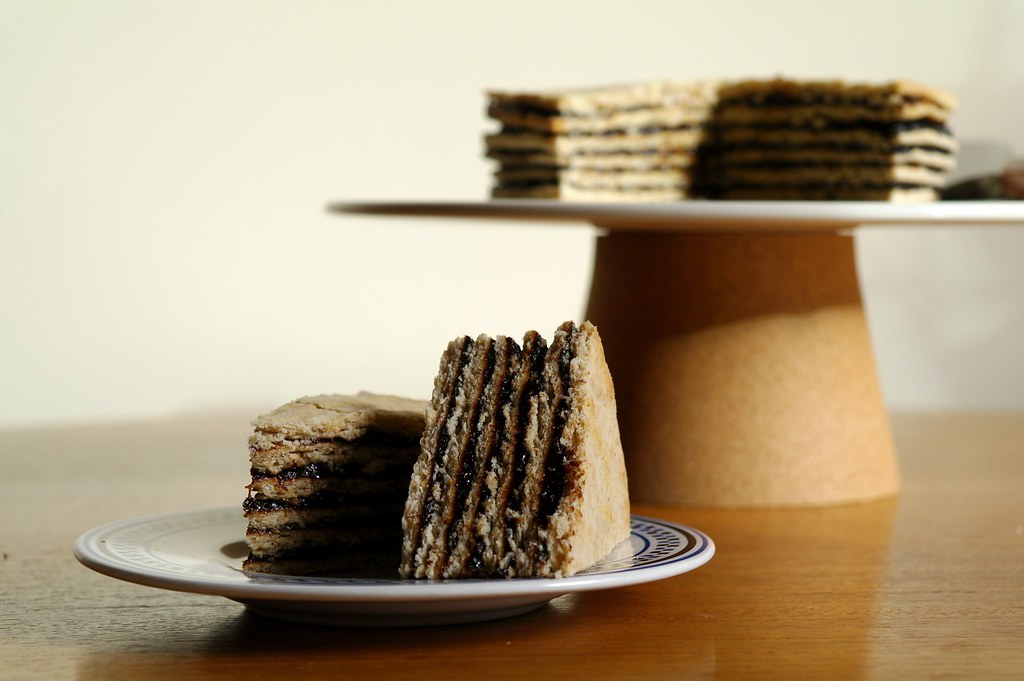
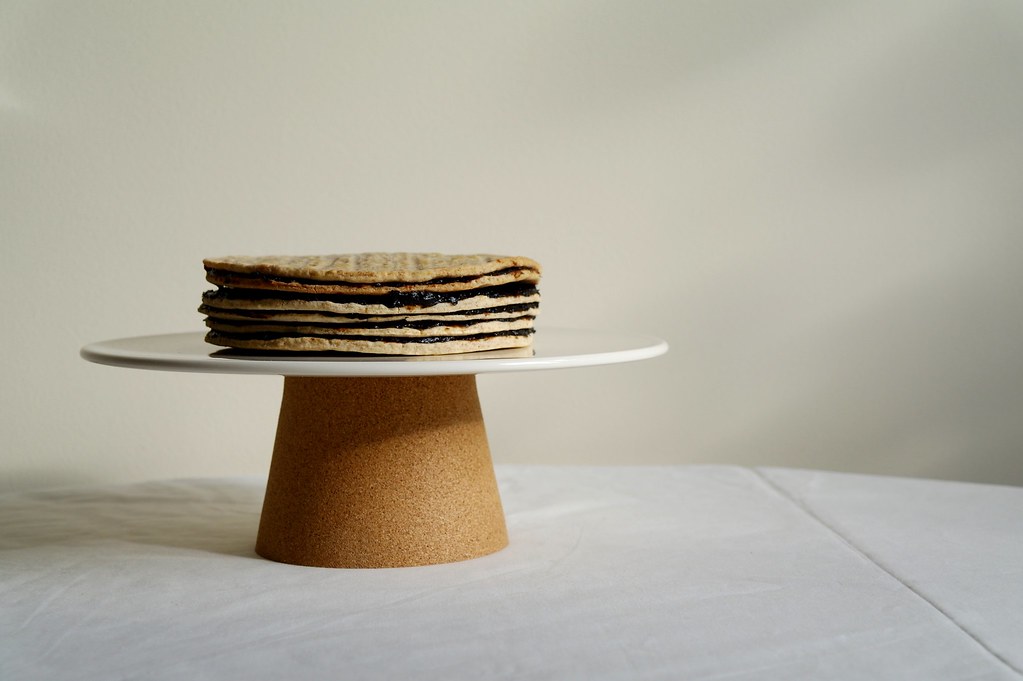 Vínarterta is a classic Icelandic Christmas cake that was brought to North America along with a wave of Icelandic immigrants around the late 18th to early 20th century. It was a thin cake that could be cooked over a hearth, and as prunes were très cher, it was very “en vogue”! The vínarterta still is en vogue, or at least in North America.
Vínarterta is a classic Icelandic Christmas cake that was brought to North America along with a wave of Icelandic immigrants around the late 18th to early 20th century. It was a thin cake that could be cooked over a hearth, and as prunes were très cher, it was very “en vogue”! The vínarterta still is en vogue, or at least in North America.
It’s like the founder effect (maybe?) but with cake. The vínarterta remains a popular and iconic Christmas cake in the Icelandic population of North America, but has become an obscurity in Iceland itself. It’s been described a “culinary time capsule.” I imagine what happens is that when you’re further from home, the traditions brought with you are treasured even more highly and can become even more resistant to change.
 As Natascha mentioned in her post on the lane cake Canada and the US do have their own food traditions and culture. While the Lane Cake was more of a “made in the USA” sort of situation, many, understandably, are derived from other places. They’ve then become unique because they have changed, or like the vínarterta, have been preserved.
As Natascha mentioned in her post on the lane cake Canada and the US do have their own food traditions and culture. While the Lane Cake was more of a “made in the USA” sort of situation, many, understandably, are derived from other places. They’ve then become unique because they have changed, or like the vínarterta, have been preserved.
I have a soft spot for desserts that can be preserved, and improve with time–such as fruitcake. This is what immediately drew my attention when I was looking up suggested cakes for Lina’s Recipe Challenge. The cake apparently lasts for months, and should be allowed to age just a little bit. Furthermore, it uses prunes. I adore prunes as one of my favourite dried fruits, so what could be better?
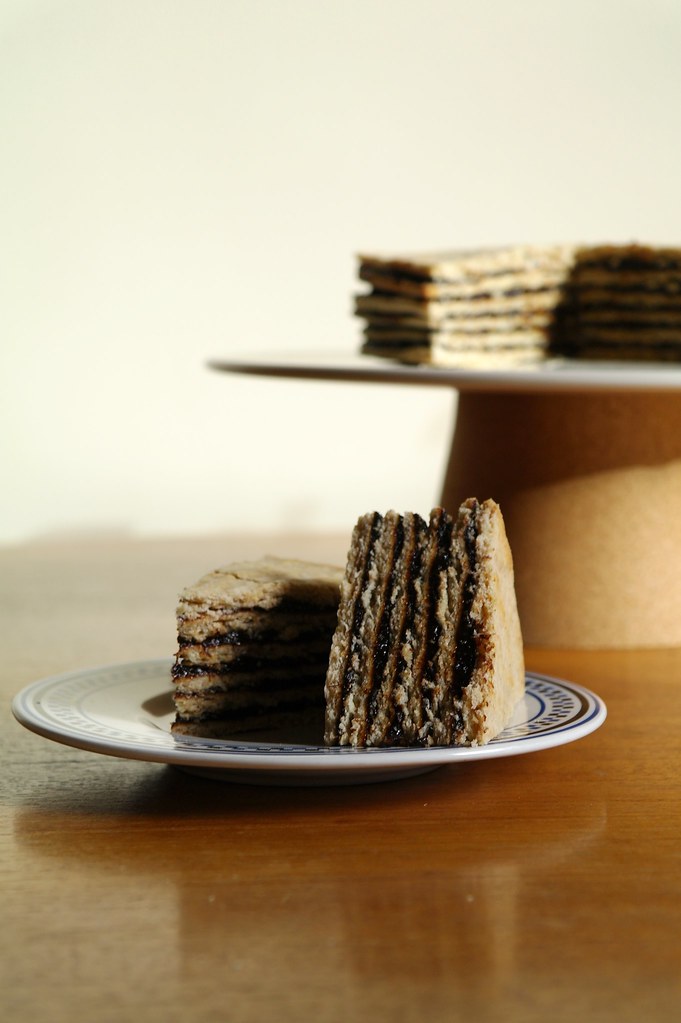 The cake is made out of 6 to 7 layers of thin cookie-like cake, spread with a thick prune and cardamom jam. Freshly made, the cake layers are essentially crispy and tough (i.e. well-structured) shortbread. After I let the cake sit for 3 days the cake layers had softened perfectly until tender, the prune jam had solidified, and the layers of cake and jam had fused together. It was difficult to stop myself from trying it earlier, but I’m glad I waited.
The cake is made out of 6 to 7 layers of thin cookie-like cake, spread with a thick prune and cardamom jam. Freshly made, the cake layers are essentially crispy and tough (i.e. well-structured) shortbread. After I let the cake sit for 3 days the cake layers had softened perfectly until tender, the prune jam had solidified, and the layers of cake and jam had fused together. It was difficult to stop myself from trying it earlier, but I’m glad I waited.
The prunes are, of course, quite sweet, but the cake overall is not a very sweet cake, which is what I prefer. I decided not to ice it, and completely forgot to dust it with powdered sugar. I don’t think it needs it.
It is a dense cake, and a very simple one. It is rich and lovely cut in thin slices served with coffee. I’ve been keeping it in the fridge, though if I want a bit the next morning, I cut a slice the night before and leave it out so it is at room temperature in the morning.
I imagine this would be a good cake to always have on hand (for months due to the long shelf-life! yes!!) for whenever someone unexpectedly comes over for coffee.
When looking around, I found mostly prune and cardamom vínarterta, but I’m excited to one day try some other flavours. I’m thinking apricot lekvar and poppy seeds for something a bit hamantaschen-like. In my reading I also came across several mentions of using rhubarb jam in the vínarterta, or in a similar cake called randalin. I think it would all be perfect with cardamom!  Lina is kindly hosting this February Cake Challenge, and it is being judged by Suzanne and Jhuls. I think Lina’s challenges have hit the perfect balance. It was fun to select your own recipe (I feel a great deal of fondness for vínarterta now), and Lina provided a fantastically curated list of suggestions to encourage everyone to try something new. As we all chose something different, now we’re able to see so many different cakes!
Lina is kindly hosting this February Cake Challenge, and it is being judged by Suzanne and Jhuls. I think Lina’s challenges have hit the perfect balance. It was fun to select your own recipe (I feel a great deal of fondness for vínarterta now), and Lina provided a fantastically curated list of suggestions to encourage everyone to try something new. As we all chose something different, now we’re able to see so many different cakes!
vínarterta
Adapted from Port and Fin and Arden Jackson via CTV. I used quite a bit of cardamom and so the cardamom flavour is very strong–I like it, but it could also be reduced if you prefer!
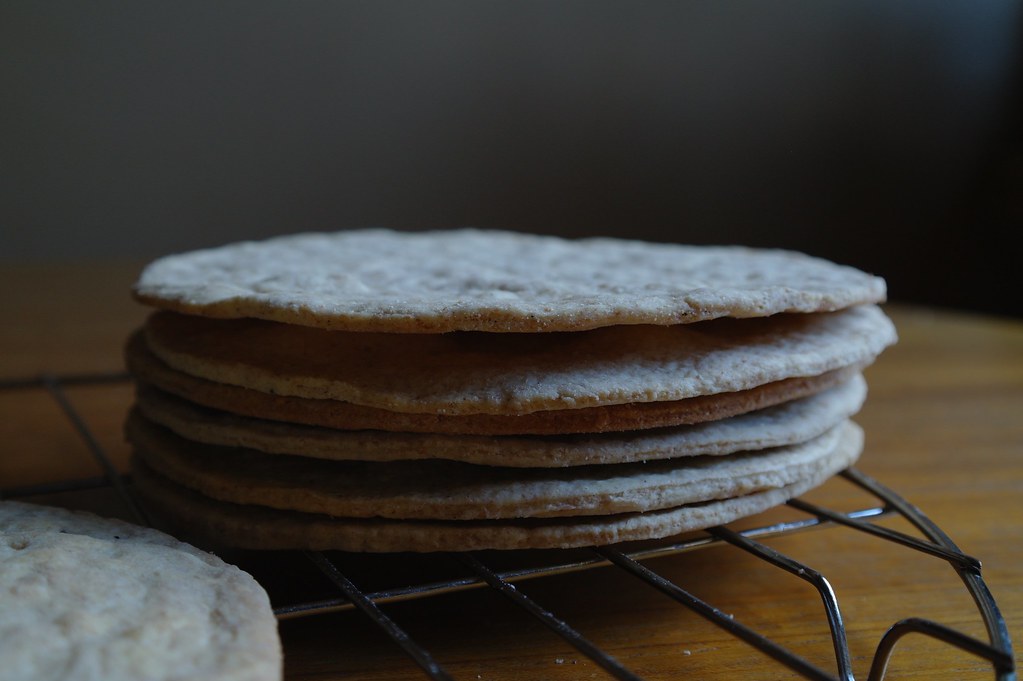
dough
- 1/4 lb butter
- 50 g sugar
- 1″ length of vanilla bean
- 1/4 tsp vanilla extract (or, more vanilla bean!)
- 1 egg
- 1 good pinch salt
- 125 g all purpose flour
- 125 g spelt flour
- 1/4 tsp baking powder
- 1/4 tsp ground cardamom
- 60 mL milk
Cream the butter and sugar. Split the length of vanilla bean, scrape out the seeds. Reserve pod for the prune filling. Add the vanilla seeds to the butter, supplement with a bit of vanilla extract, and mix. Beat in the egg.
Whisk together flours, salt, baking powder and cardamom.
Add a quarter of the flour to the butter mixture, then half the milk, a quarter of the flour, the remaining milk. Lastly, mix in the last half of the flour.
Wrap in plastic and chill.
Preheat oven to 375F.
Divide the dough into 6 pieces. Roll each one out onto a floured surface until just bigger than a 7″ diameter circle. Lift up the dough from the counter to release any tension and allow the dough to shrink if necessary. (I also tried just leaving the dough on the counter long enough to relax, however due to the moisture content it began to stick to the counter and so it usually ended up deforming when it was peeled from the counter. Use a 7″ diameter cake pan as a guide to cut out an even circle. Place on a parchment lined sheet and bake for around 10-15 minutes or until cooked through and slightly browned along the edges.
Repeat with the remaining pieces of dough, reserving the scraps. I had enough scraps to then make a seventh layer, but I let it shrink too much to use in the final cake. You can bake a couple layers on the same tray to bake two at a time. I finished off some layers on the bottom rack of the oven briefly so they had a bit more browning.
prune filling
- 240 g prunes
- 1″ vanilla bean pod (reserved from the dough)
- 3 green cardamom pods
- 3/4 tsp ground cardamom
- 3/4 tsp vanilla extract
Place the prunes in a saucepan, along with the pod of the vanilla bean and the three green cardamom pods (crack the pods with the heel of your hand). Cover the prunes with water and bring to a simmer. Let simmer until the water evaporates (which took around 20 minutes for me). Stir occasionally, especially near the end as the water evaporates and the prunes could possibly burn against the bottom. If the prunes are completely softened, continue–otherwise, add some additional water and continue to cook down until the prunes are soft. Remove the vanilla bean pod (which will be a bit difficult to find, so you may want to remove it the prunes start breaking down) and the green cardamom pods.
I continued to add water and cook until the prunes broke up and began to disintegrate. Cook until the mixture is thick and pasty. Beat with a wire whisk until the prunes are broken up and form a slightly lumpy puree. Whisk in the cardamom and vanilla extract. Let cool completely before layering.
assembly
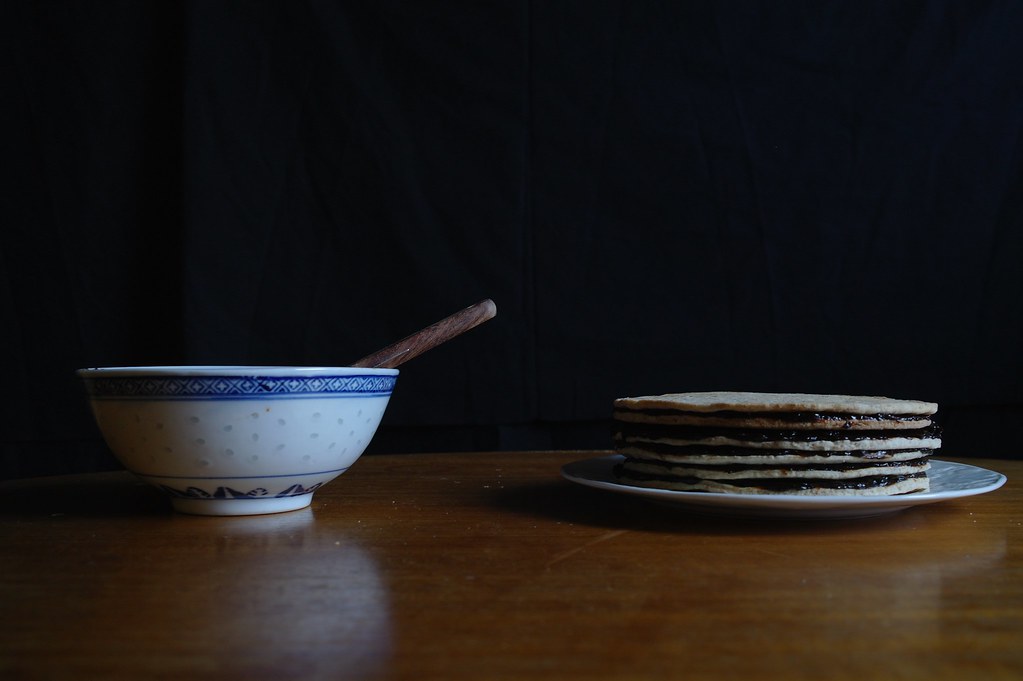
The edges of the cake layers can be sanded with a small serrated knife to smooth out any rough edges or decrease the size of some layers if they’re a bit too big.
Spread each layer, except for one which will be the top, with a thin layer of the prune jam. (Do not stack them and then spread the prune jam on each layer as it can cause the jam to squish out of the bottom layers, and each layer is a bit delicate and could crack.) Stack on top of each other and wrap in paper and then a plastic bag. Set it aside, I would say do it in the fridge, to age for a few days.
When you’re ready to try some, take it out and let it come to room temperature. Serve, cut into thin slices, with coffee.

I’ve never heard of this before, it reminds me a little of a crepe cake. The filling sounds delicious and it would be fun to experiment with different flavors.
LikeLiked by 1 person
It has the same thin layers as a crepe cake but the texture is very different! It is quite rich and heavy. I am excited to give some other flavours a try, and probably experiment a bit with the cookie layers as well–I think I may see about adding some egg and cutting back on the milk! 🙂
LikeLiked by 1 person
Lovely post and really amazing pictures! You have done some awesome work on the research…..I’m so glad you participated ☺. Atb! A great post once again and a good choice of recipe 😊
LikeLiked by 1 person
Thank you for hosting this challenge and encouraging us all to try something different Lina! I usually don’t do research on the history, but it’s so interesting to learn, especially after reading the research everyone else did on their cakes as well 🙂 All the best to you as well! 🙂 xx
LikeLiked by 1 person
☺☺☺☺
LikeLiked by 1 person
You did such a wonderful job:) I love the addition of cardamom, it goes really well with desserts 🙂
LikeLiked by 1 person
Thank you Freda! I think I have to restrain myself from adding cardamom to everything! I’ve come to love it in all desserts… it seems to go with everything, nuts and fruits and other spices 🙂
LikeLiked by 1 person
Oh yeah! exceptionally well with desserts ! It’s my favorite spice in the pantry:)
LikeLiked by 1 person
I think it’s my favourite as well!! 🙂 🙂
LikeLiked by 1 person
It looks so beautiful and I like the filling with prunes. A very interesting recipe. Well done Laurie. Have a nice weekend! 🙂
LikeLiked by 1 person
Thanks Linda! I love the prune filling as well. It is thick and spreadable, and of course has plenty of cardamom in it! I didn’t puree it, so I was worried about it not being smooth, but the prunes aren’t too fibrous and the skins broke down with enough cooking. A lovely weekend and upcoming week to you as well! 🙂
LikeLiked by 1 person
Wow! This is beautiful! The history is interesting and I have a fondness for cakes that need to age a bit before eating them . The result is worth the wait!! I would love to try this!! ❤❤❤👍👍👍👏👏👏
LikeLiked by 1 person
Haha, thank you Natascha! The aging just adds to the excitement and anticipation 🙂
LikeLiked by 1 person
👏👏👏👏👏👏👏👍👍👍👍👍
LikeLiked by 1 person
Wow, this cake looks lovely. I love prunes, but haven’t bought them in ages for some reason. What a perfect winter filling! I like being introduced to new recipes from all over the world, and this is a new type of cake for me. I will definitely keep this recipe close.
LikeLiked by 1 person
Thank you Jenny 🙂 I have the opposite problem: I love prunes, and normally have some around, but they’re always dried out. Well, at least this is a good way to use up the old prunes! It is certainly very winter-y…a rhubarb filled vinarterta would be a good summer filling.
LikeLike
A very unique and interesting cake. And it lasts for months!! Wow!!
Thank you for sharing.
LikeLiked by 1 person
Thank you Ana 🙂 I really like that long-lasting aspect of the cake, and now there’s always a bit around!
LikeLiked by 1 person
Looks delicious 😋
LikeLiked by 1 person
Thank you Trupti 🙂 Especially with a cup of coffee!
LikeLiked by 1 person
👌🏼👌🏼
LikeLiked by 1 person
Great write up.. Prunes filling?? Wow man.. amazing. I bet prunes would have gone well with this think cake. Sounds delish.
LikeLiked by 1 person
Thanks Srividhya! Have to love those prunes…I think they’re one of the best dried fruits–soft and plenty sweet 🙂
LikeLike
I have never heard of this cake before and that’s whay I love about Lina’s challenge – it introduces me to rare recipes like this. This looks so pretty and yummy, Laurie. Glad to have you here. 🙂 x
LikeLiked by 1 person
I’ve learned a lot from Lina’s challenge as well. It’s such a fantastic idea! Thanks to you and Suzanne for taking the time to judge the challenge 🙂 xx
LikeLiked by 1 person
Oh my goodness what is this beautiful cake!! This reminds me so much of a crepe cake but somehow heartier!! I love it because it’s not exactly a pancake either. 😍 your photos are always impossibly gorgeous and so natural. You’re my muse!
Also what is this monthly baking challenge stuff? That sounds interesting!
LikeLiked by 1 person
Thank you so much!! It’s definitely a dense and hearty cake! It goes quite far–I still have half of it in the fridge (and another quarter was sneaked into my grandparent’s fridge 🙂 ).
I encourage you to check out some of the challenges! This was for Lina’s cake challenge, and for April she’s doing a surprise challenge (https://lins239.wordpress.com/2016/03/09/surprising-april-challenge/)–intimidating+exciting!! It’s a fun way to be motivated to blog and try something new 🙂
LikeLiked by 1 person
I’ve noticed the best way to finish off desserts is to take them to work. 😂 people are like rabid animals at work, and they will eat EVERYTHING. 😂
And thank you for the link! I think I might try it out. I’ll be more motivated if I have somebody suggesting something hehe.
LikeLiked by 1 person
Haha, that is true! Any setting with a lot of people around is good for those sorts of things. I’ll just have to preface it with the fact that the cake is a month old now (but as good as ever I think 🙂 ).
The challenges are definitely motivating–and who knows what Lina will suggest!! 😀
LikeLiked by 1 person